101
The Pacific Northwest’s long summer days, climate, and acidic soil provide ideal conditions for cultivating berries. Delicious by themselves and a great addition to breakfasts, salads and smoothies, berries also preserve well in the freezer or as jellies and jams. Regardless of how you use them, local berries are one of summertime’s greatest gifts. Blueberries, blackberries, and red raspberries are popular and will be around all summer, but you don’t want to miss the lesser-known berries that make an all-too-brief appearance between June and August, so here’s our guide to a berry good summer.

Golden Raspberries
Floral, with a velvety, delicate form, raspberries are the embodiment of summer’s fleeting sweetness. Golden raspberries have a more subtle flavor than their red counterparts, but equally delicious when eaten fresh. Easily muddled into a cocktail, and when used in desserts, layer fresh berries over cake and dust with powdered sugar or fresh whipped cream
Availability: Late June
Tayberries
A cross between a raspberry and a blackberry, the tayberry is the answer to anyone who loves raspberries, but wish the fruit was twice as large and a bit firmer. Its unique fingertip-like shape is an almost comical version of a berry, and its extra sweetness will make anyone thankful for its “super-sized” form, while enjoyed as a fresh snack.
Availability: Late June


Boysenberries
An American hybrid of raspberry, blackberry, dewberry and loganberry, this fruit of many forebears is sweet and slightly tart, with an elongated fruit shape. Named for its grower, Rudolph Boysen, the boysenberry is typically made into jams and jellies, given its fragile structure and short growing period, but those in the Northwest can sample it fresh from the vine, as a rare treat.
Availability: Mid to late July
Nectarberries
Thought to be a variant of the boysenberry, the nectarberry resembles a giant blackberry, and typically sweeter. Sometimes packaged as boysenberries, the nectarberry is often grown in home gardens and not as widely cultivated for commercial farms, so take the opportunity to try it fresh if you see it!
Availability: Late June




Currants (red, black, white)
Small, spherical currants have seen a comeback in the United States after a nearly century-long ban on the ribes species, which had spread a disease that affected pine trees during the early 1900s. The ban since lifted, the return of currants has seen these tart berries made into sauces and jams, paired with both savory and sweet dishes, its acidity balancing out the richness of pork, duck, or creamy desserts.
Availability: Late June
Gooseberries
The size of a marble, this grape-like relation to currants is also seeing a return to US as a light, refreshing snack. The pulpy, juicy berry can be eaten while the skin is green, offering a tart flavor, but if you prefer a sweeter grape-like taste, wait until the fruit turns a blushy red hue. It contains small, edible seeds, offering a satisfying textural crunch, similar to a cherry tomato, and can be baked into tarts, made into a syrup, or preserved as jellies and jams.
Availability: Late June


Strawberries
Ah, the humble strawberry. They can generally be found during most of the year, but the PNW-grown strawberries that pop up in June are in a league of their own. These gems are generally a bit smaller than the strawberries seen in stores year-round and are so much sweeter. Grown just outside of Seattle in Puyallup, Washington.
Availability: Mid June





